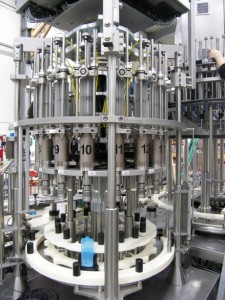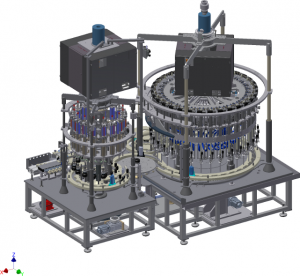The use of linear – rotary motors in closure lines to enable frequent product changeovers
Capping processes can be designed much more flexibly with linear-rotary motors than with conventional cam disc technology. Tölke, a packaging machinery specialist, has outfitted a new high-performance filling and closing line for a well-known pharmaceutical company with linear-rotary motors from LinMot. The resulting benefits included shorter setup times, lower downtime, and a wider range of applications for the machine.

Tölke specialises in machinery for bottle closing and capping machines and provides complete lines for sorting, aligning, filling and capping for well-known manufacturers in the beverage and cosmetics industries. These cappers have an output up to 500 bottles per minute with a packaging cycle for each bottle of only 0.12 seconds however when Tölke was commissioned for a high performance filling and capping line for an application that required frequent product changeovers a more flexible solution was required.
A limitation of conventional cam-stroke technology, as utilised in traditional capping machines, is that, if the closing process itself needs to be modified for a product changeover, it is usually necessary to change out the mechanical cams involved in the linear motion of the screwing process. This is a time-consuming and costly process and modern production lines require quick product changeovers. As a consequence a carousel machine was developed with 16 closing stations. The entire screwing process is handled by one linear-rotary motor (model PR01-84) at each station.
This electric motor, part of the PR01 series from LinMot, was specially developed for the closing and screwing process. It combines both a linear motor and a rotary direct drive in a compact housing, each of which is controlled separately. This means that any combination of linear and rotary motions can be implemented.
“For the rotary part of the screwing process, we have been using a rotary servomotor instead of a pneumatic motor for a long time wherever the screwing application requires a defined turn angle and a defined torque, and when we want to perform a product changeover at the push of a button,” explains Franz-Josef Patzelt, one of the managing directors of Franz Tölke GmbH.
What is new, however, is the use of an electronic linear axis in the closer.
“The cap needs to be picked up, placed on the bottle, and then guided so as to provide optimal support for the rotary motion,” says Markus Kröger, the Tölke project manager responsible for this job. “If this linear motion were controlled by a cam disc, then the heights at which the cap is picked up and placed down would be fixed, and the entire motion sequence would be defined.”

If modifications to the motion sequence were required for a product changeover, then the mechanical solution would require different closure heads or even different cam discs to be installed, or the machine builder would have to integrate adjustable cam discs. In some cases, a spring would also need to be installed to compensate for the weight of the head.
“With a direct drive and an electronic stroke curve, none of this is needed anymore,” explains Markus Kröger. With the right parameter sets for the programmed motion sequence, or by invoking a predefined recipe, the motion of the linear motor can be designed as needed and optimally adapted to the individual requirements of the application.”
This means that different types of closures, including screw-on and press-on caps, can be processed on the same machine. Even different press forces or thread pitches, such as are found on containers with and without safety caps, can be handled by a linear drive without any mechanical reconfiguration.
In addition, a linear-rotary motor like the PR01, with its two independently controlled axes, can start the rotary motion during the linear stroke, decoupled from the position of the turntable. The machine builder therefore has more freedom when designing the machine, allowing the cycle time to be shortened.
Other advantages include modularisation of the machine, simple changeover of the screwing station and the ability to analyse the data produced by the drive (torque, speed, angle, vertical position, speed and force) to improve performance.
“We can use the data provided by the drive to determine the number of revolutions actually performed, so that a separate check of the height of the closed container in order to monitor the screwing process can also be eliminated,” adds Franz-Josef Patzelt, citing a practical example.
Tölke have considerable expertise in this area and had developed a solution prior to the use of the PR01 linear-rotary motor, wherein the linear motion was generated by a servomotor in conjunction with a ballscrew spindle. The ballscrew, however, had to be protected against dust, which requires additional design effort that is not necessary for the fully assembled linear-rotary motor.
“The linear-rotary motor from LinMot is much simpler to use, as an integrated unit, and takes up less space,” says Markus Kröger. “The PR01 is thus the ideal solution for lines like our high-performance closing machines, where the rotary screwing process must be as flexible and efficient as possible.”
To find out more about linear-rotary motors take a look at our web site or alternatively we would love to hear from you.
